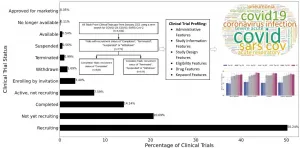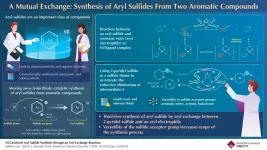Residential proximity to oil and gas drilling linked to lower birthweights in newborns
2021-07-21
(Press-News.org) A new study from Oregon State University found that infants born within 3 kilometers of oil and natural gas drilling facilities in Texas had slightly lower birthweights than those born before drilling began in their vicinity.
The study, published today in the journal Environmental Health Perspectives, found that the type of drilling or resource being extracted did not change the result.
"Most studies to date focus exclusively on unconventional natural gas drilling, or fracking. That particular process is a small subset of the oil and natural gas industry. We find it doesn't matter -- where people are extracting oil and gas resources, we're still seeing an impact on infant health," said study author Mary Willis, a postdoctoral researcher in OSU's College of Public Health and Human Sciences. "A lot of policy is exclusively focusing on fracking, but our study shows that's a really limited view of how this industry may impact local populations."
Developing fetuses are highly sensitive to environmental pollution and contaminants, so to measure potential impact, this study examined birthweight and location data for 2,598,025 mother-infant pairs in Texas between 1996 and 2009 in which the mother was pregnant while living within 10 kilometers of a current or future oil or gas drilling site.
Prior research estimates that 4.5 million Texans live within 1.6 kilometers (one mile) of at least one oil or gas drilling site. However, little work to date has focused on the population health impacts of living near an oil or gas drilling site in Texas, the state that produces the most oil and gas in the U.S.
The potential exposures related to drilling are numerous: air pollution from drilling activities, flaring and increased traffic going to and from the drilling site; water contamination from hydraulic fracturing chemicals; noise pollution from industrial activity and increased traffic; and light pollution from new drilling facilities.
After accounting for other potential factors influencing birthweight, Willis and the research team found that living within 3 kilometers of an active drilling site was associated with a birthweight 7 to 9 grams lower than the birthweight of babies born before drilling began.
It's a relatively small impact, Willis said, but a lot of women live near oil and gas wells and the impact at a population level could be significant.
"So it's concerning, but this magnitude of effect is smaller than similar papers because we take into account the economic benefits of drilling," she said. The industrial boom of a new drilling site, particularly in rural areas, can bring new jobs, higher wages and better access to quality health care alongside the increased environmental pollution.
There is also a lot of data that isn't represented on birth certificates alone, Willis said: Researchers hypothesize that there may be more early-pregnancy losses and difficulty conceiving among families in the areas around drilling sites.
With this study, Willis said the team hoped to give policymakers a standard safe distance for drilling, but they found the health impact doesn't totally dissipate at 3 kilometers (nearly 2 miles).
"In the U.S., 17.6 million Americans live within 1.6 kilometers of at least one active oil or gas drilling site. That's a lot of people residing really close to fossil fuel extraction," Willis said.
Ongoing and future studies Willis is involved in are examining the potential impact of oil and gas drilling sites on the rate of birth defects, preterm birth and maternal health, as well as specific exposures that may be responsible for potential health effects.
INFORMATION:
ELSE PRESS RELEASES FROM THIS DATE:
2021-07-21
In order to win the battle against COVID-19, studies to develop vaccines, drugs, devices and re-purposed drugs are urgently needed. Randomized clinical trials are used to provide evidence of safety and efficacy as well as to better understand this novel and evolving virus. As of July 15, more than 6,180 COVID-19 clinical trials have been registered through ClinicalTrials.gov, the national registry and database for privately and publicly funded clinical studies conducted around the world. Knowing which ones are likely to succeed is imperative.
Researchers from Florida Atlantic University's College of Engineering and Computer Science are the first to model COVID-19 completion versus cessation in clinical trials using machine learning algorithms and ensemble learning. The study, ...
2021-07-21
Scientists at St. Jude Children's Research Hospital have found a link between post-cancer treatment frailty and neurocognitive decline in young adult childhood cancer survivors. A paper on this work was published today in the Journal of Clinical Oncology.
Though frailty is often associated with the elderly, 8% of young adult childhood cancer survivors meet the criteria for frailty. This study confirms that those who undergo childhood cancer treatment can experience frailty, which can create an early onset of neurocognitive decline in young adults. This study will help with further research to prevent such neurocognitive decline.
"We ...
2021-07-21
To reach the target of carbon neutral, a transition from fossil energy to renewable energy generation is indispensable. Photovoltaic technology is considered as one of the most prominent sources of renewable energy. For decades, about 90% of global solar cell market has been dominated by silicon solar cells. Although the price of silicon solar panels decreases year by year, it is a big challenge to significantly reduce its manufacturing cost further. Hence, next-generation photovoltaic technologies are in urgent need of new materials and novel techniques. Recently, metal halide perovskite solar cells (PSCs) have attracted extensive attention from both academia and industry, due to their excellent photoelectric conversion efficiency and great commercial potential.
Metal halide perovskite ...
2021-07-21
One of the major challenges in modern cancer therapy is the adaptive response of cancer cells to targeted therapies: initially, these therapies are very often effective, then adaptive resistance occurs, allowing the tumor cells to proliferate again. Although this adaptive response is theoretically reversible, such a reversal is hampered by numerous molecular mechanisms that allow the cancer cells to adapt to the treatment. The analysis of these mechanisms is limited by the complexity of cause and effect relationships that are extremely difficult to observe in vivo in tumor samples. In order to overcome this challenge, a team from the University of Geneva (UNIGE) ...
2021-07-21
In the United States, climate change is controversial, which makes communicating about the subject a tricky proposition.
A recent study by Portland State researchers Brianne Suldovsky, assistant professor of communication, and Daniel Taylor-Rodriguez, assistant professor of statistics, explored how liberals and conservatives in Oregon think about climate science to get a better sense for what communication strategies might be most effective at reaching people with different political ideologies. The study was published in Climatic Change in June.
Prior studies have shown that exposing climate change skeptics, ...
2021-07-21
Over the past six months, the World Health Organization has categorized four SARS-CoV-2 variants as being "of concern" because they are more transmissible or may escape the immune response. They have been termed the Alpha, Beta, Gamma and Delta variants. Scientists from the Institut Pasteur, in collaboration with the French National Health Insurance Fund (CNAM), Ipsos and Santé publique France, conducted a nationwide case-control study to evaluate the effectiveness of mRNA vaccines against symptomatic forms of SARS-CoV-2 infection, be that non-variant virus or the Alpha and Beta variants. The results show that the two-dose vaccination regimen of mRNA vaccines provides 88% protection against non-variant virus, 86% against the Alpha variant and 77% against the Beta ...
2021-07-21
Tsukuba, Japan - Rice is the world's most commonly grown and consumed crop. It also supports lives and livelihoods, especially in low- and middle-income regions. As such, methods for securing abundant and profitable rice harvests are key in global food security.
The System of Rice Intensification (SRI) offers a repeatable, sustainable system for increasing rice yields. It brings together fundamental planting and harvesting techniques such as strategically spacing plants, minimizing water, and transplanting seedlings. These practices can be repeated in varying conditions. While SRI has been around since ...
2021-07-21
Since buildings consume 75% of electricity in the U.S., they offer great potential for saving energy and reducing the demands on our rapidly changing electric grid. But how much, where, and through which strategies could better management of building energy use actually impact the electricity system?
A comprehensive new study led by researchers from the Department of Energy's Lawrence Berkeley National Laboratory (Berkeley Lab) answers these questions, quantifying what can be done to make buildings more energy efficient and flexible in granular detail by both time (including time of day and year) and space (looking at regions across the U.S.). The research team, which also included scientists from the National Renewable Energy Laboratory (NREL), found that ...
2021-07-21
Aryl sulfide, an aromatic compound in which sulfur is attached to an aryl (a functional group derived from an aromatic ring), is found in biologically active materials effective against asthma, Alzheimer's disease, and cancer. As a result, chemists have shown a lot of interest in synthesizing aryl sulfides. Traditionally, carbon-sulfur (C-S) bond formation reactions between thiols and aryl electrophiles catalyzed by transition metals have been employed for aryl sulfide synthesis because of their high reliability. However, thiols have an unpleasant smell and are toxic. Could there be a way to synthesize aryl sulfides that avoids the ...
2021-07-21
A new study of almost 12,000 Australians has found one-third of the adult population has experienced pure cybercrime during their lifetime, with 14% reporting this disruption to network systems in the past 12 months.
With all forms of cybercrime already costing trillions every year globally, experts from the Australian Institute of Criminology (AIC) and Flinders University say the crimes involved substantial levels of personal victimisation including direct losses as well as the high cost of preventing future attacks.
A pre-COVID-19 snapshot of the cost of 'pure cybercrime' in 2019 has found an approximate ...
LAST 30 PRESS RELEASES:
[Press-News.org] Residential proximity to oil and gas drilling linked to lower birthweights in newborns






